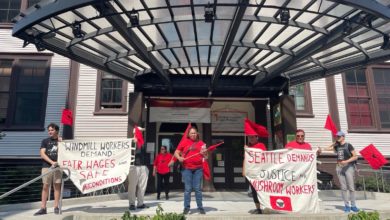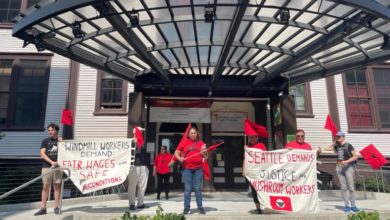The fare enforcement system in place on Seattle area RapidRide bus lines has come under scrutiny in the wake of a report on the cost and efficacy of fare enforcement by the King County Auditors Office. Fare enforcement is provided by Securitas, a private company under contract with King County. That contract will expire in September, and while there is every indication that it will be renewed, the terms may be revised to include performance metrics and other data that will indicate whether or not fare enforcement is having the effect that it was intended to have. While the goal of the system is ostensibly to reduce the number of riders who do not pay their fare, the report has found that not only does the fare enforcement system have no appreciable impact on the number of unpaid fares, but it does additional harm to the most marginalized people served by the King County Metro system.
The current fare enforcement system disproportionately impacts people who are experiencing homelessness or housing instability, first by saddling people who depend on public transportation the most with onerous fines that are difficult to pay. The audit found that 25 percent of all citations issued between 2015 and 2017 were issued to people experiencing homelessness or housing instability. These fines go into collections when left unpaid (as happened with 97 percent of citations issued in 2016) which generates a negative impact both in terms of the increased cost of the fine itself, compounded with the collections fees, while also lowering the person’s credit score. For people in the precarious position of surviving on the street, this can be, and has been, a major barrier to reentry into stable housing.
For those who receive multiple citations, this can result in a charge of misdemeanor theft being brought against them. Approximately 30 percent of these misdemeanor cases in the same time period were leveled against people experiencing either homelessness or housing insecurity. The additional costs and assorted difficulties associated with court proceedings can very often spiral into an impossible situation when combined with the day to day struggle of sheltering on the streets in capitalist society.
Workers in technology or other white-collar fields are also less likely to be penalized for fare evasion because of the prevalence of employer-subsidized transit passes offered by large companies such as Microsoft or Amazon. The result is that many of those riders who are in the position to be able to pay their fare out of pocket are not required to do so, while those who could most benefit from subsidized transit passes are left to pay the full fare each time.
The fare enforcement system is massively expensive, and does not produce enough revenue to cover its expenses. While the city of Seattle wrestles over funding sources for much needed assistance programs that could lift people out of homelessness, it spends nearly $1.7 million per year on a fare enforcement program that directly and disproportionately harms those same people. The same amount, if spent to subsidize transit for those in need, could cover the cost of over half a million bus tickets, easily eclipsing the 3,911 citations issued for fare evasion between 2015 and 2017. Current programs of fare enforcement are both a senseless waste of public resources and intensely harmful to those of our neighbors who are already struggling to survive.
Instances of fare evasion appear to be relatively low on the RapidRide system compared to other similar systems in cities such as Portland and Atlanta. While, as the report itself makes explicitly clear, there is often assumed to be a causal link between fare evasion and fare enforcement, this assumption is not borne out by the evidence. The audit compares data from differing “jurisdictions” in various cities and concludes that jurisdictions with high levels of fare enforcement report similar levels of fare evasion to those with relatively low fare enforcement. As is the case with the U.S. criminal justice system in general, the idea of deterring crime through the threat of harsh punishment has been shown to be without merit.
Startlingly, the system currently in place does not even have a mechanism for measuring the impact of fare enforcement efforts on the rate of fare evasion. In other words, there is no way for administrators to internally evaluate the impact of fare enforcement efforts on the rate at which riders pay their fare, even if they wanted to. The glaring lack of any such accountability points to a system that is wholly uninterested in the tangible results of its efforts.
Warnings, citations and misdemeanors for fare evasion are issued in wildly fluctuating proportions on a case by case basis. The KCAO report compares two individual riders with similar numbers of penalties, 42 in the first case and 45 in the second. While the overall number of penalties was similar, the first individual received 38 fines and 4 misdemeanors, whereas the second individual received 23 fines and no less than 22 misdemeanors. While this disparity may or may not represent the average variation in all cases, the fact that it is possible for such wide gaps to exist in the application of these burdensome fines and criminal charges is cause for alarm, and an invitation to serious abuses.
Anecdotal evidence and the experiences of other major cities with mass transit fare enforcement suggest that people of color will be targeted in disproportionately high numbers for citations and especially for criminal charges. However, such data are not even being gathered, let alone analyzed. What little information does exist is incomplete to the point of uselessness, comparing different routes at different times and collecting too little information to show whether or not fare enforcement citations are given in proportion to overall demographic representation. The lack of any such data shows that, at best, Securitas and the King County Council that employs and oversees them are simply not considering the impacts of fare enforcement on people of color.
As the report itself made clear, the fundamental logic underlying the current system of fare enforcement is fatally flawed. It is explicitly designed to elicit a particular result, the reduction of unpaid fares. Yet no clear evidence exists to tie the ratio of paid to unpaid fares to the presence of fare enforcement officers on buses. Rather than spending nearly $2 million a year on a system that effectively criminalizes the use of the public transportation system by the poorest riders, the city of Seattle should be using that money to subsidize public transportation with a view to improving accessibility for those at the lowest income levels and particularly for those sheltering on the street. We demand that King County Council prioritize access to transportation for those who need it over the enrichment of a private security company and the criminalization of poverty in Seattle.





